Table of contents
Employee recognition software platforms used to be a nice extra. Now, they’re a must-have for companies that actually want to keep their people engaged, productive, and sticking around. It’s more than a feel-good moment. Achievers’ State of Recognition Report shows monthly recognition makes employees 47% more likely to feel committed to their jobs. That’s not fluff. That’s impact.
Still, recognition can be tricky. It has to feel real. It has to happen often. And it has to work for every team — from the frontlines to the C-suite. That’s where the right platform comes in. The best ones don’t just make recognition easier — they make it part of how your organization works.
So, which platform does it best? We’ve rounded up the top employee recognition software platforms of 2025 — along with a quick comparison — to help you find the right fit.
Let’s take a look.
- Achievers
- Mo
- Worktango
- Motivosity
- Kudoboard
- Nectar
- Assembly
- TerryBerry
- Guusto
- Cooleaf
- Workhuman
- Awardco
- O.C.Tanner
- Reward Gateway
- Bonusly
What are the best employee recognition software platforms?
The best platforms are simple, impactful, and fit seamlessly into your company’s culture. When it comes to comparing employee recognition platforms, look for ones that offer:
- An intuitive interface: Easy to use and accessible for all employees
- Mobile access: Enables recognition anytime, anywhere
- Peer-to-peer and top-down recognition: Encourages participation at all levels
- Advanced integrations: Connects with tools like Slack, Microsoft Teams, and Outlook
- Measuring and reporting tools: Provides insights to track impact and optimize your program
These features ensure recognition is effortless, consistent, and aligned with your business goals.
The 15 best employee recognition software platforms for 2025
1. Achievers
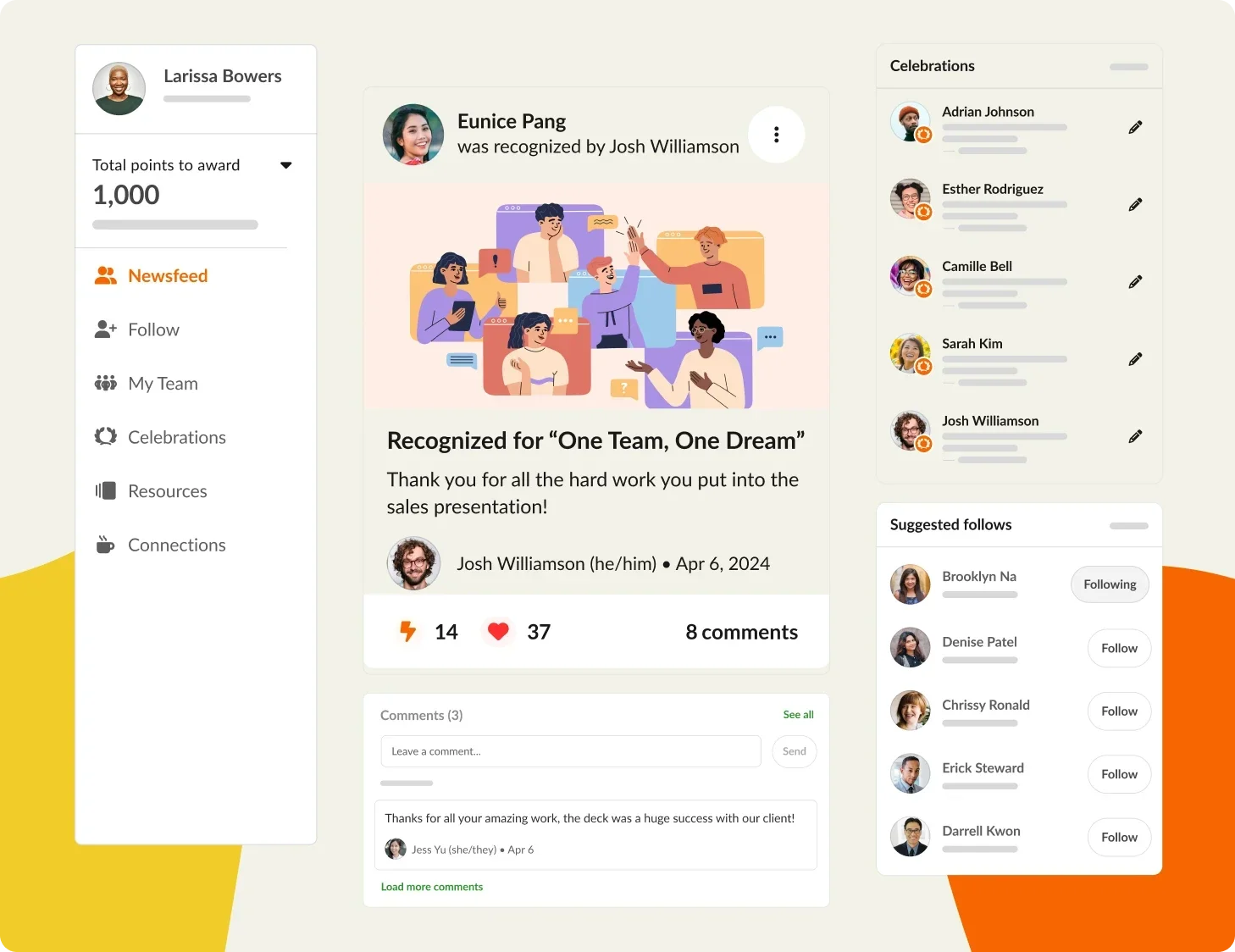
Achievers is a science-backed employee recognition platform that helps teams feel valued — and stay connected — every day. It’s built to reinforce the behaviors and values that drive real results, with recognition that’s timely, personalized, and easy to give, no matter where your people are.
With social recognition, points-based rewards, and a company newsfeed that actually feels like good news, Achievers helps organizations celebrate wins of every size. It’s about more than good vibes — recognition done right drives real outcomes. Frequent, meaningful recognition helps build connection, boost engagement, and reinforce the values that move your company forward.
Leaders can instantly see what’s resonating and where engagement may be slipping — giving them the data to take action before it starts to affect performance. And with Voice of Employee tools built in, your recognition program stays aligned with culture and informed by what your people actually value.
Built to work where your teams already do — in platforms like Slack, Outlook, and Teams — Achievers makes recognition frictionless and in-the-moment, not locked in a separate system.
G2 rating: 4.7/5
Key features:
- Recognition that reaches over 4 million employees across 164 countries, with translations in 32 languages
- Millions of meaningful reward options, delivered locally in 190 countries — with no markups
- Live support from real humans, plus dedicated customer success managers
- Recognition tools that work online and offline — built for in-office, remote, and frontline teams
- Two-way feedback with flexible reporting and real-time analytics
- Recognition and engagement insights backed by the Achievers Workforce Institute
Review: “Using Achievers, we have been able to make recognition fun, inclusive, and global at Kellanova. We now have the tool to show our people just how much we value and appreciate them in a public and creative way.” – Elizabeth Smith, Sr. Manager, Global Total Health, Kellanova customer
2. Mo
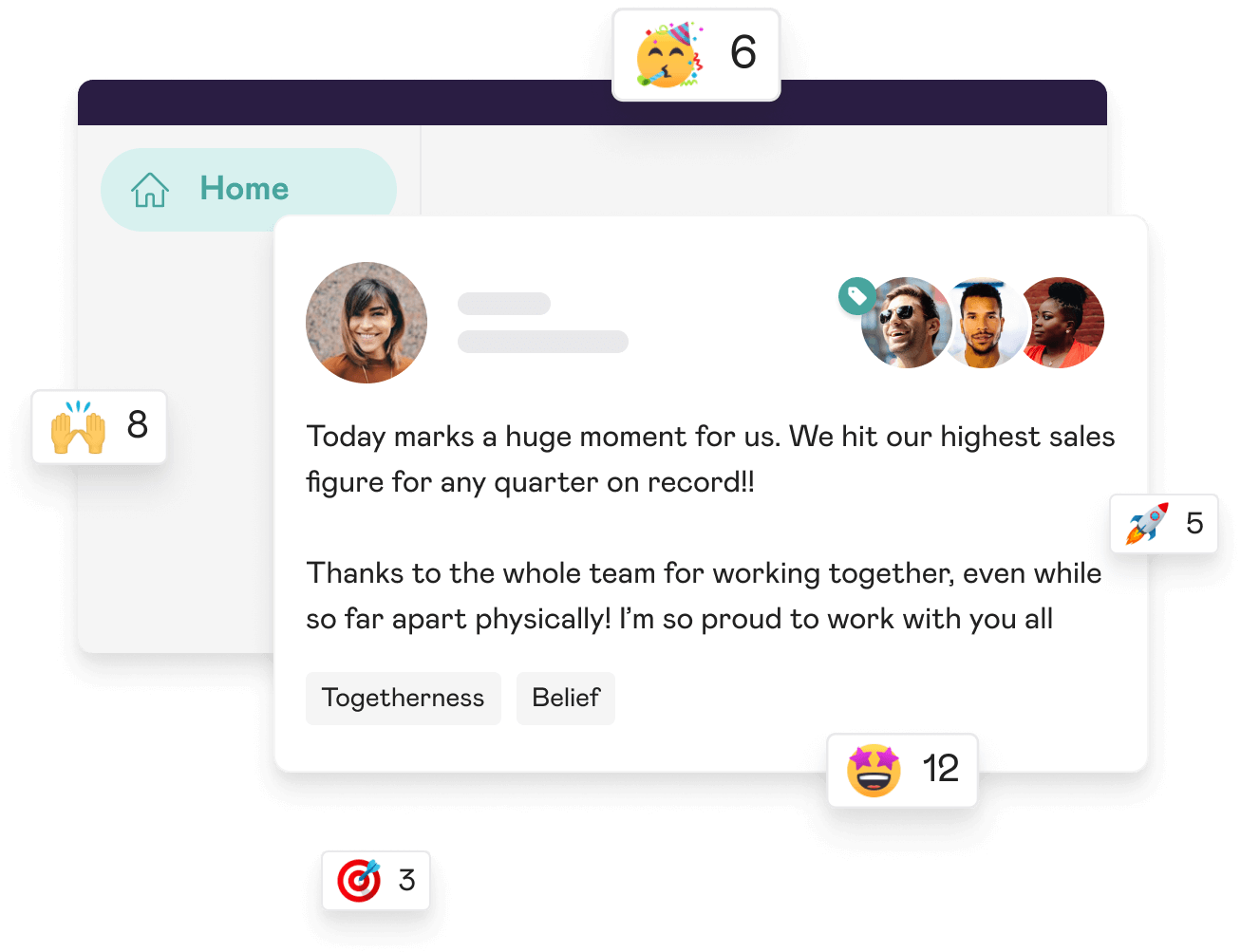
Mo is an employee recognition platform built around celebrating “Moments” — short, social posts tied to company values. The platform empowers employees to celebrate wins, milestones, and shout-outs in real time, whether publicly or privately. Managers receive weekly prompts to encourage consistent recognition, while HR and leaders benefit from built-in analytics to measure program success. However, while it offers core features like a customizable rewards catalog and basic analytics, Mo leans more on simplicity and social interaction than robust enterprise-scale functionality.
G2 rating: 4.6/5
Key features:
- Peer-to-peer recognition through Moments, tied to company values
- Manager engagement tools, including weekly prompts
- Customizable rewards catalog
- Real-time program analytics and engagement tracking
- Seamless mobile and desktop access for hybrid teams
Review: “I think it is a very useful tool to learn different things about the company and to be able to interact with other coworkers in a friendlier and different way than usual. It is easy to use and allows you to consult the page for different doubts or questions that you may have.” — David F., Data Warehouse Modeller, via G2
3. Worktango
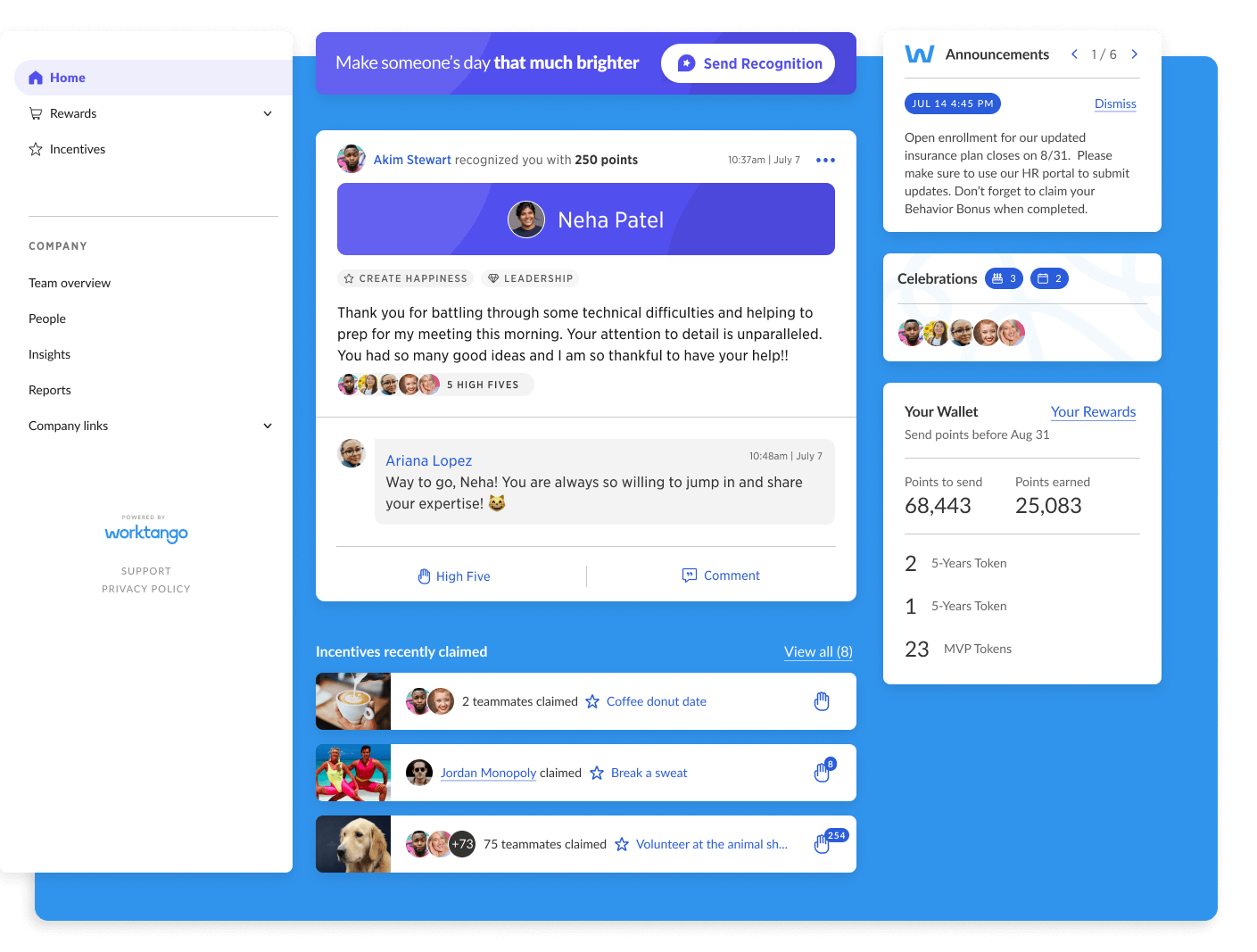
Worktango offers a flexible recognition experience that lets companies tailor their approach — with or without points. The platform is designed to support participation in company initiatives, automate milestone celebrations, and help leaders track recognition activity by department, role, or region. WorkTango’s strength lies in its integration of recognition with surveys and feedback tools, making it well-suited for organizations focused on employee listening. However, those looking for more advanced reward personalization or international catalog options may find some limitations.
G2 rating: 4.7/5
Key features:
- Run recognition with or without points, tokens, or rewards
- Built-in employee surveys and engagement insights
- Automated years of service and milestone celebrations
- Integrations with Slack, Microsoft Teams, and Outlook
- Recognition analytics by department, location, or role
Review: “Excellent tool for engaging, inspiring, and retaining employees. Easy to implement, needs little training, and saves a lot of time for surveys and data analytics. Very useful for goals and feedback — it leads to time savings and greater manager efficiency.” — Finance professional, via Gartner
4. Motivosity
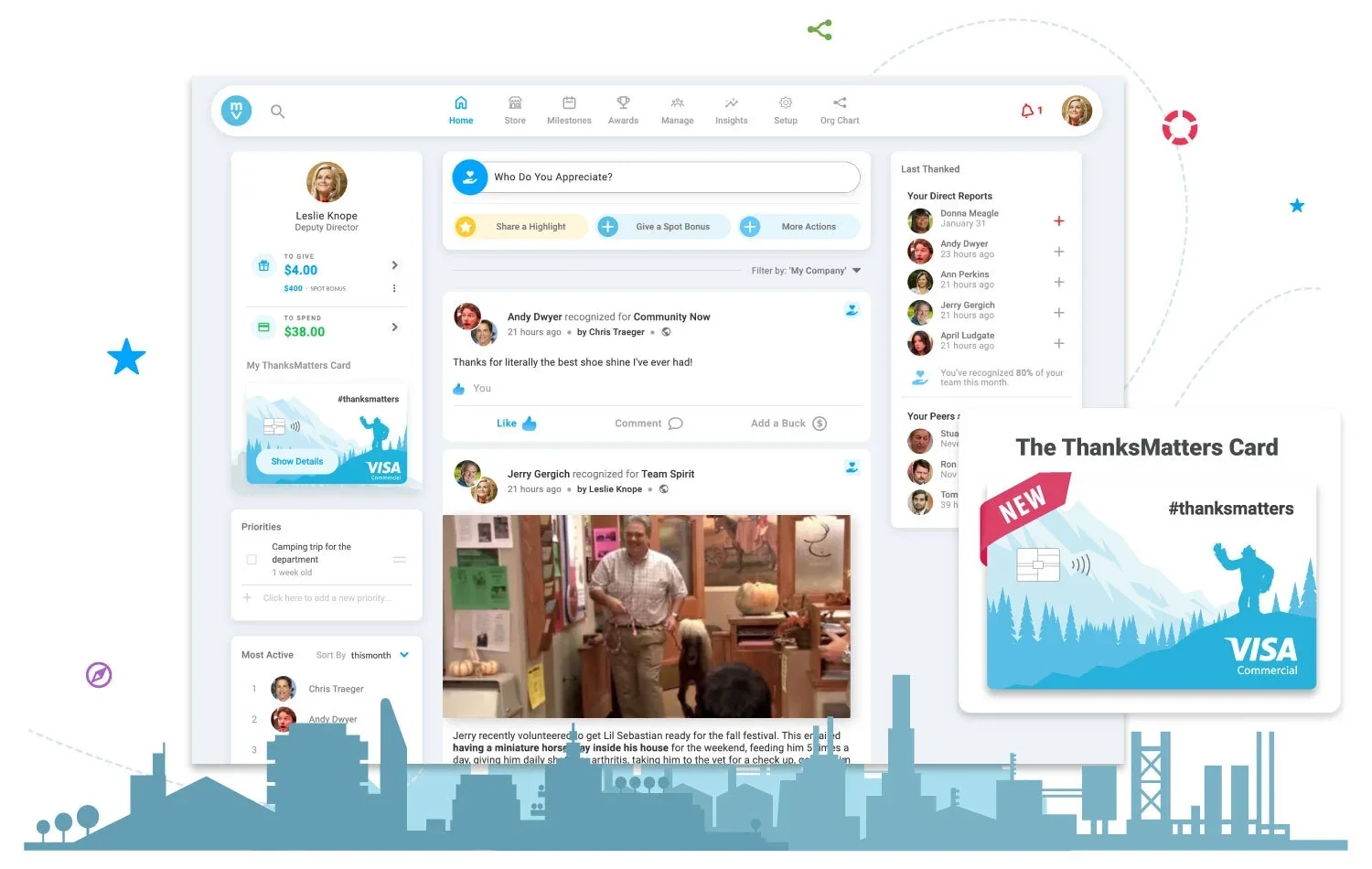
Motivosity focuses on recognition that’s social, flexible, and reward-driven. Employees can send peer-to-peer shout-outs and pair them with real monetary bonuses, while managers can create spot awards or automate celebrations for milestones like birthdays and work anniversaries. The platform offers a global rewards catalog and the ThanksMatters Visa card for easy redemption. While it excels at driving regular engagement through incentives, companies looking for deeper survey or culture analytics may need to supplement with additional tools.
G2 rating: 4.7/5
Key features:
- Peer-to-peer recognition with optional monetary bonuses
- Automated milestone celebrations and service awards
- Custom awards, employee challenges, and leader-driven badges
- Global rewards marketplace with branded swag and gift cards
- Real-time reporting and the ThanksMatters Visa for seamless redemption
Review: “I love the interaction it allows especially in a bigger company, spread across multiple office locations and states. It allows us all to stay connected and see the good work those within the company are doing, even from a different location. I love the recognition it provides.” — Rachel, Executive Assistant, via Capterra
5. Kudoboard
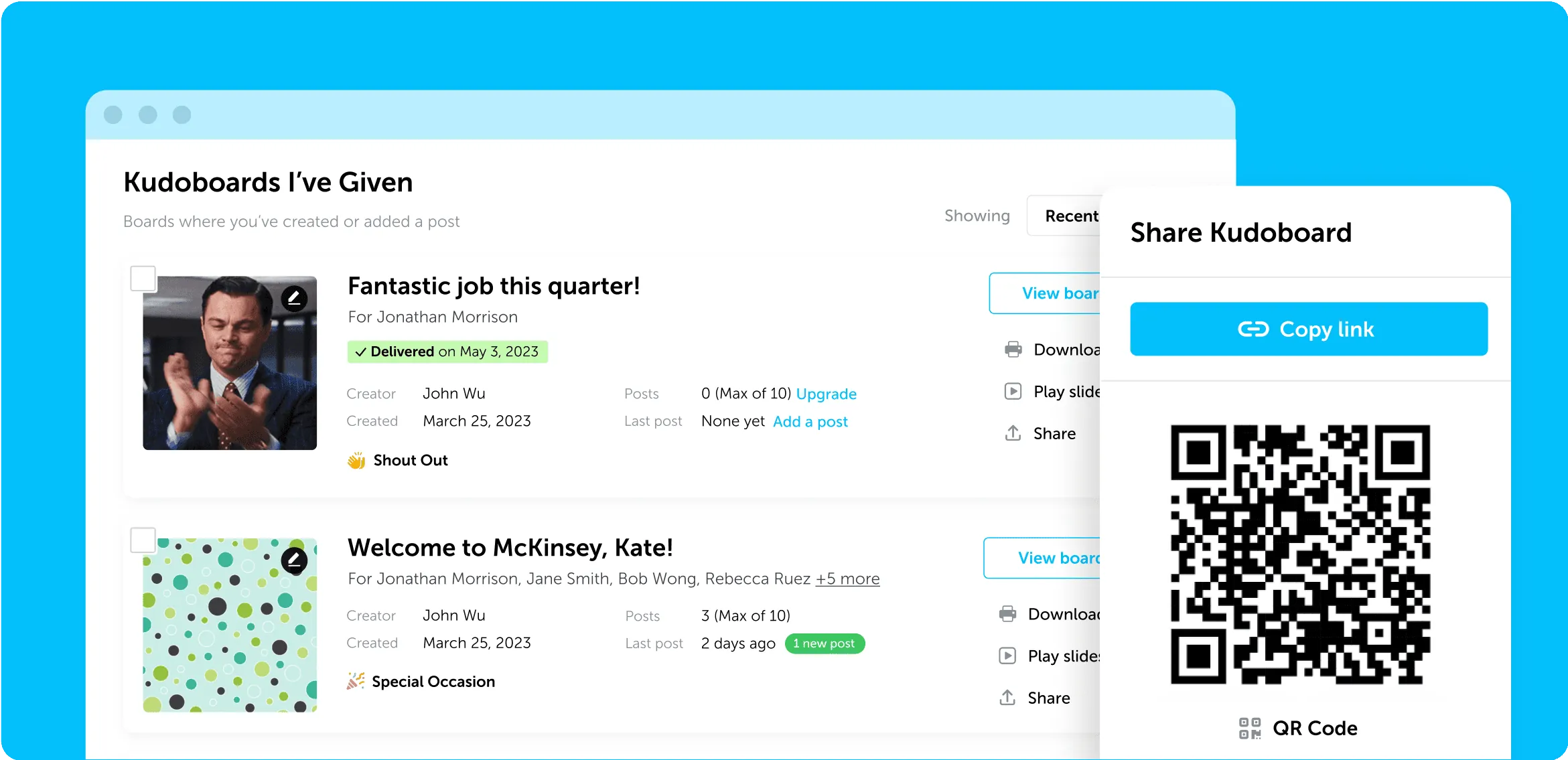
Kudoboard takes a visual, card-based approach to recognition, offering teams a creative way to celebrate milestones and moments that matter. Employees can collaborate on digital group cards — filled with GIFs, messages, photos, and videos — and present them as slideshows, posters, or hardbound books. It’s a fun and personal tool for birthdays, farewells, and work anniversaries. While not a full-scale recognition platform, Kudoboard excels at making appreciation more heartfelt and memorable.
G2 rating: 4.8/5
Key features:
- Collaborative group eCards with rich media and personalization
- Automated birthday and milestone card delivery
- Print options include posters and hardbound books
- Integrations with Slack, Microsoft Teams, and HRIS platforms
- Custom branding and enterprise controls for large-scale use
Review: “So far we have used Kudoboard for birthdays, anniversaries and other similar celebrations. I have not run into any issues yet. I have no experience with customer service and so far pricing is ok but that may become an issue as I am looking to use kudoboard for company wins and shoutouts which really requires an upgrade in my subscription type.” — Kat Z., Executive Assistant, via G2
6. Nectar
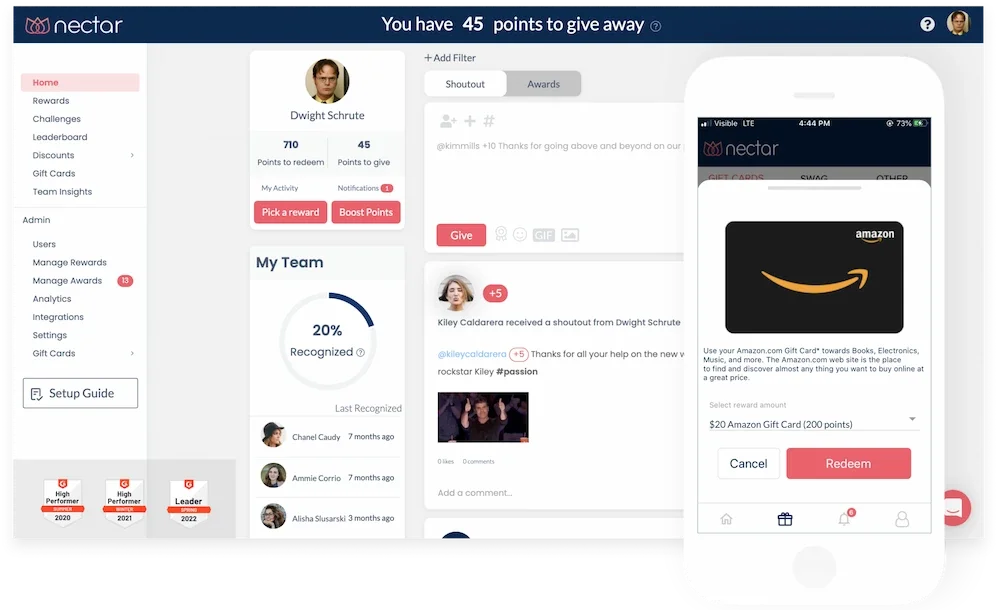
Nectar is a user-friendly recognition and rewards platform that makes it easy for employees to send shout-outs, celebrate milestones, and redeem points for rewards that actually matter. Peer-to-peer recognition is tied to core values, and automated birthday and service award features help keep celebrations consistent. Nectar also supports internal nominations and team challenges to drive engagement. While it’s a great fit for companies looking for simplicity and speed, larger enterprises may want more advanced configuration options.
G2 rating: 4.7/5
Key features:
- Peer-to-peer recognition linked to company values
- Customizable rewards, including gift cards, swag, and Amazon items
- Built-in nomination and challenge programs
- Automated milestone and birthday celebrations
- Integrations with HR tools and SSO for easy access
Review: “We use nectar for staff and management to reward employees exceptional work with points. Also, it is useful in terms of keeping employees connected with each other and interested in each other’s work by allowing them to engage in a way similar to social media. It also was helpful for management to see areas of staff success that otherwise may go unseen, which was particularly helpful in things like formal evaluations.” — Lisa P., Head of People and Culture, via Select Software Reviews
7. Assembly
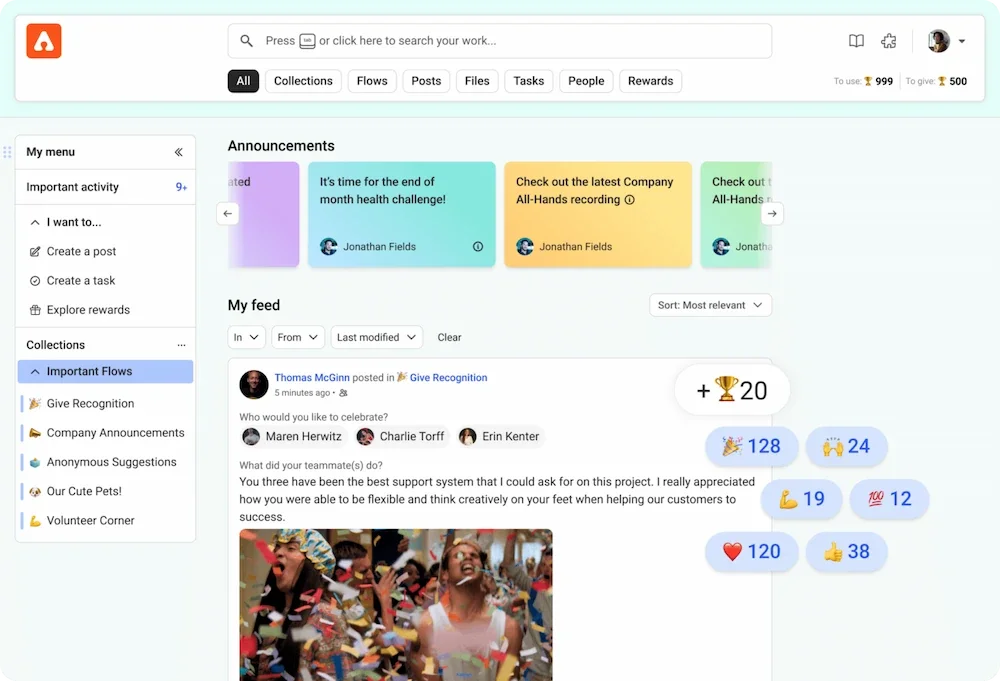
Assembly is a culture-building platform where recognition is one of many integrated tools. It offers ready-made workflows for shoutouts, nominations, milestones, and awards — all customizable to reflect your company’s values and branding. With peer-to-peer recognition, automated celebrations, and a robust rewards marketplace, it helps embed appreciation into everyday routines. While not a dedicated recognition-only solution, Assembly is ideal for companies looking to combine recognition with broader engagement and workflow features.
G2 rating: 4.9/5
Key features:
- Peer-to-peer and manager-driven recognition with points
- Built-in templates for awards, nominations, and challenges
- Automated milestone celebrations for birthdays and anniversaries
- Global rewards marketplace including Amazon, travel, and swag
- Integrations with Slack, Teams, and HRIS platforms
Review: “I like being able to write a post showing appreciation for my team members, a post that the entire company will see, so that they get the recognition they deserve. Sometimes as individual contributors at a larger company, it’s easy to get lost in the shuffle or just be another cog, but this allows us all to be highlighted for our hard work.” — Nathan B., Software Engineer, via G2
8. TerryBerry
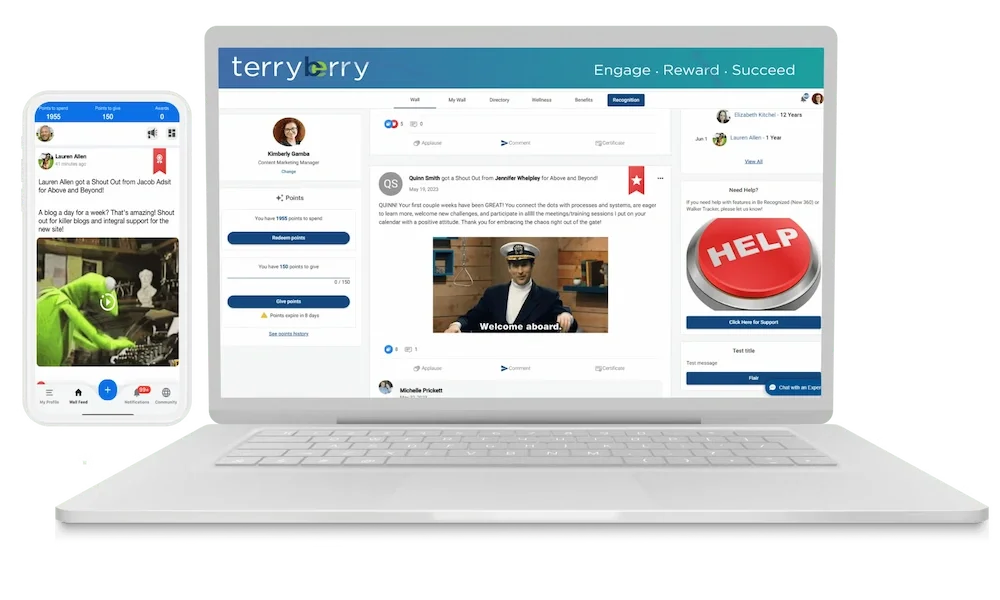
Source: www.terryberry.com
TerryBerry’s “Be Recognized” platform blends recognition with broader engagement tools, including wellness tracking, milestone automation, and employee surveys. The platform supports peer-to-peer and manager-driven recognition, along with service awards and incentives. Employees can redeem points for custom-branded swag, charitable donations, or merchandise from a global catalog. Backed by over 100 years of recognition expertise, Terryberry offers scale and flexibility — though it may be best suited to organizations seeking a full-spectrum engagement platform rather than a recognition-only tool.
G2 rating: 4.6/5
Key features:
- Peer and manager recognition with points-based rewards
- Extensive global rewards catalog, including Amazon integration
- Automated milestone celebrations for birthdays and anniversaries
- Wellness and engagement survey tools
- Multilingual support across 150+ countries
Review: “There might be bugs or technical restrictions with Terryberry, but from what I’ve seen, they fix any problems right away. By consistently delivering updates with new features, they also show a dedication to always developing their programme, which is fantastic to see. To make sure people are aware of the changes, it would be advantageous if they increased their communication with reference to these upgrades.” — Pat E., Accounting Associate, via G2
9. Guusto
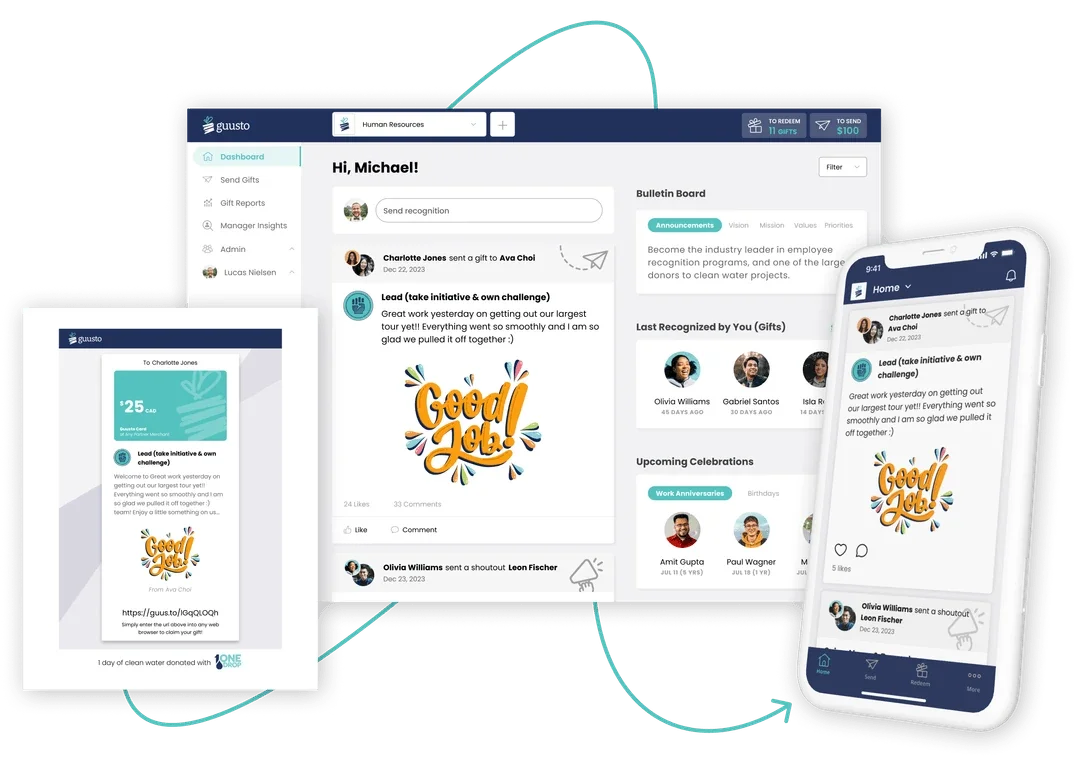
Guusto is a lightweight, no-frills recognition platform built for simplicity, speed, and frontline accessibility. It lets organizations send real-time rewards or shoutouts without needing employee emails, complex point systems, or expensive upfront commitments. The platform supports pilot programs and scales easily with flexible delivery options, making it a strong fit for industries like hospitality, retail, and healthcare. While it doesn’t include deeper engagement tools like surveys or performance tracking, Guusto excels at delivering instant, inclusive appreciation.
G2 rating: 4.9/5
Key features:
- No-points reward system — $1 always equals $1
- Peer, manager, and milestone recognition programs
- Redemption at 60,000+ global merchant locations
- Offline-friendly options: QR codes, SMS, printable rewards
- Only pay for users who send recognition
Review: “I do greatly appreciate that Guusto is most convenient to use, offering ease and efficiency in managing rewards. The platform provides an impressive variety of incentives, particularly in the form of merchant gift cards, which can be redeemed at numerous establishments…Some users have expressed frustration with Guusto’s limited merchant selection, especially in certain regions, and feel more stores should be added for greater variety.” — Mohammed, Solution Architect, via Capterra
10. Cooleaf
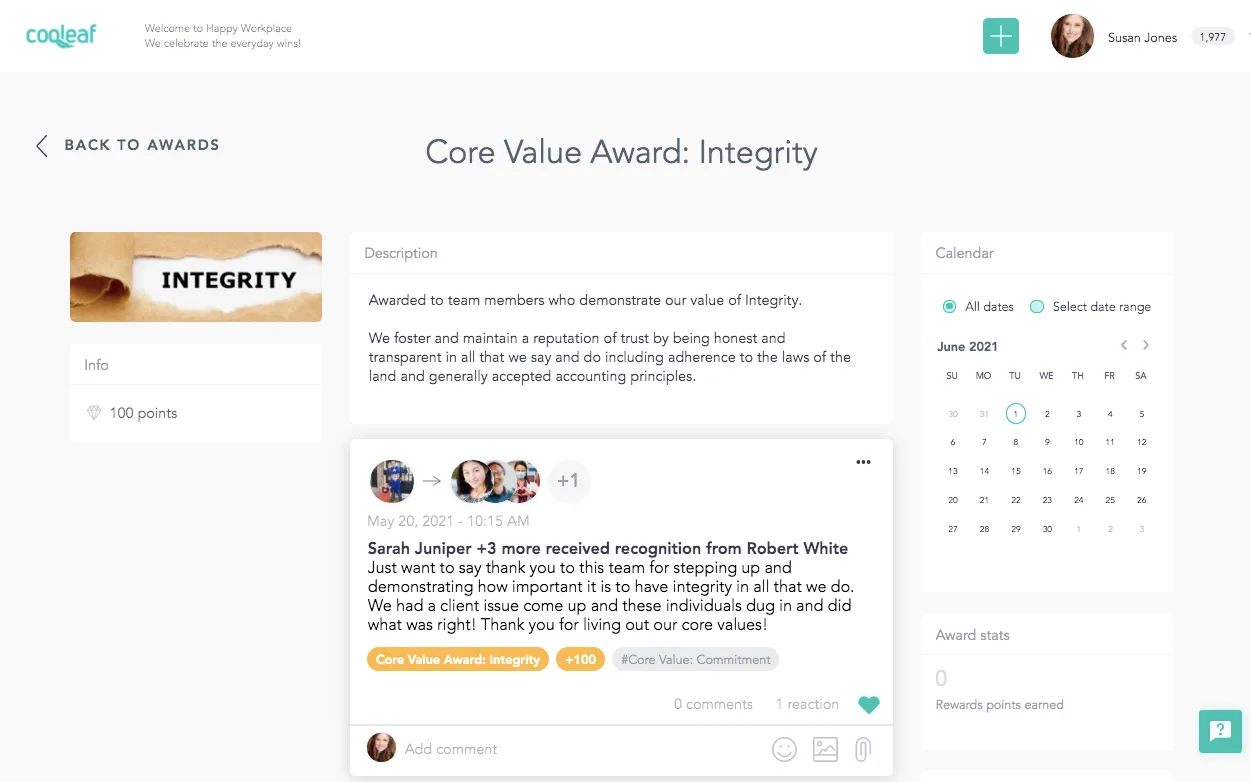
Cooleaf blends recognition with a full suite of engagement tools, offering everything from real-time shoutouts and milestone rewards to wellness, DEI, and learning initiatives. Its built-in feedback tools make it easy to track eNPS, manager effectiveness, and engagement trends in one place. While ideal for organizations looking for an integrated platform, companies seeking a pure-play recognition tool may find Cooleaf’s feature set broader than they need.
G2 rating: 4.9/5
Key features:
- Peer and manager recognition tied to core values
- Automated work anniversary and milestone rewards
- Engagement surveys with AI-powered insights
- DEI, wellness, and learning program support
- Centralized dashboard to measure impact and performance
Review: “Cooleaf offers more capabilities and I like ease of conducting surveys. It also helps with employee engagement and recognizing unique talents is easy.” — Gedion, Customer Manager, via Capterra
11. Workhuman
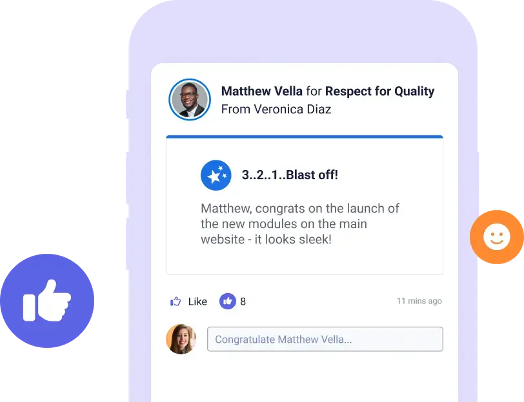
Workhuman is a recognition platform built to bring more humanity into the workplace. Its “Social Recognition” tool drives peer-to-peer appreciation, celebrates milestones, and tracks life events — all while generating rich data to inform culture strategy. With AI-powered insights and global capabilities, it’s designed for large organizations seeking measurable impact. That said, its breadth of tools may feel more complex than needed for smaller teams focused solely on core recognition.
G2 rating: 4.7/5
Key features:
- Peer, manager, and milestone recognition
- AI-driven reporting and engagement analytics
- Global rewards catalog across 180+ countries
- Inclusion Advisor to reduce bias in recognition
- Seamless integrations with Microsoft Teams, Slack, Outlook, and Workday
Review: “The platform works really well but could be a bit more intuitive. For example, when I click on my points on the top right corner, I expected to see a table containing my awards and my current points but instead I am redirected to the store. Once you get used to it, it works fine but a better UX/UI could make it easier for new users.” — Operations reviewer, via Gartner
12. Awardco
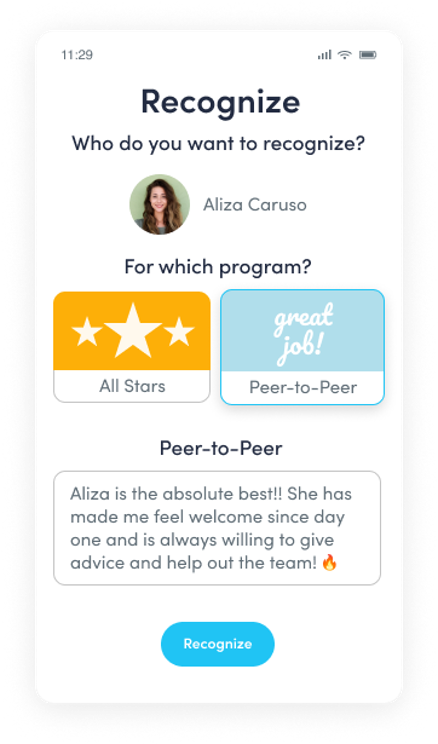
Awardco blends recognition with a rewards engine powered by Amazon — giving employees global flexibility to redeem points for what they actually want, without any markups. The platform supports spot recognition, anniversaries, and incentive programs, all backed by automated workflows and deep customization. While that level of control is great for large, complex organizations, smaller teams may find the options a bit overwhelming.
G2 rating: 4.9/5
Key features:
- Amazon-integrated reward catalog with 300M+ options
- Spot recognition and milestone celebrations
- Budgeting tools and AI-powered analytics
- Offline and external recognition tools for frontline teams
- Integrations with Slack, Teams, Outlook, and more
Review: “Awardco is very easy to use. I like having lots of reward choices, especially Amazon. It’s also great that you can get gift cards if you don’t see what you want. It’s a good way for companies to reward good work and make people feel appreciated…I’d like more ways to earn points, like maybe doing surveys. Also, it would be great if we could use our points at more online stores. For example, instead of just Amazon, maybe we could use them at Target or Best Buy too.” — Diego M., Field Service Technician, via G2
13. O.C. Tanner
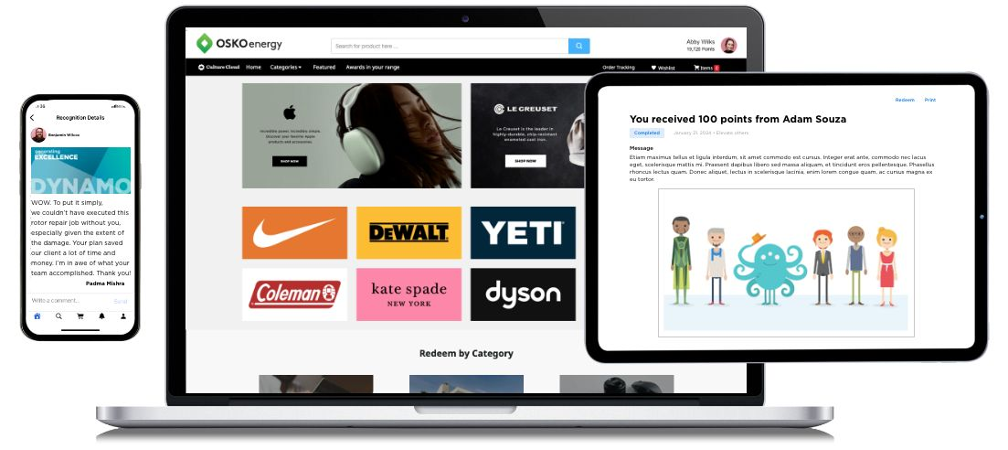
O.C. Tanner’s Culture Cloud platform combines recognition, service awards, and cultural celebrations in one enterprise-ready solution. Designed for large organizations, it supports peer-to-peer appreciation, milestone recognition, and company-wide initiatives — all backed by insights from the O.C. Tanner Institute. While its robust feature set is built to scale, it may lack the flexibility and real-time feedback capabilities some teams need to shape culture more dynamically.
G2 rating: 4.8/5
Key features:
- Peer recognition, anniversary, and celebration tools
- Custom symbolic awards and branded swag
- Culture analytics and risk indicators
- Integrations with major HRIS and communication tools
- Offline and mobile-ready recognition options
Review: “Culture Cloud is most versatile tool for companies which gives priority to employee satisfaction, retention, and engagement through employee recognition and rewards. This tool increases motivation and productivity among employees and it provides easy and quick way to be recognized and get awarded.” — Research and Development reviewer, via Gartner
14. Reward Gateway
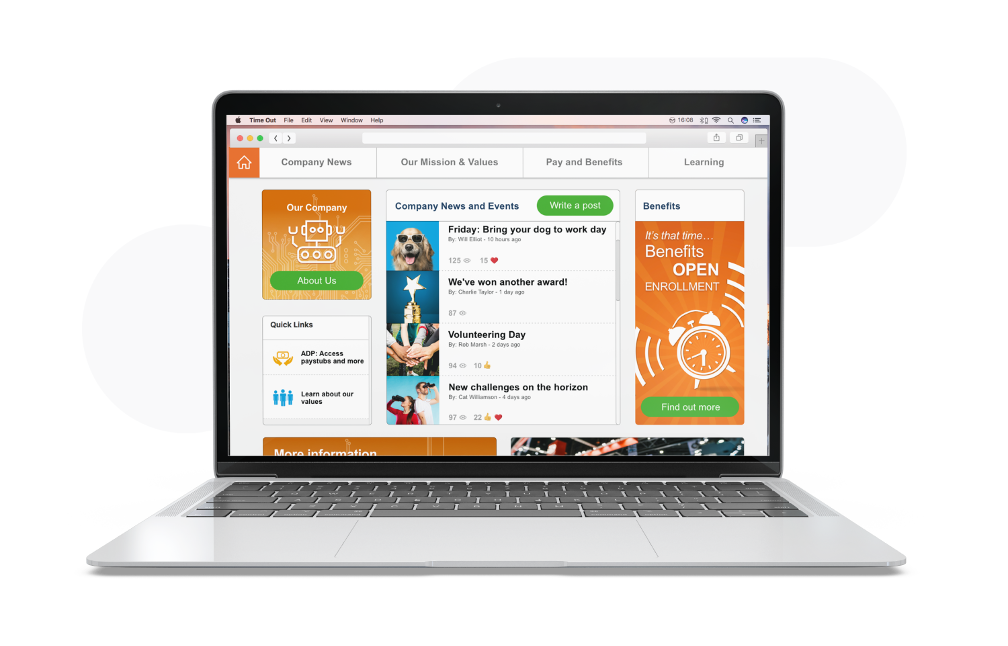
Reward Gateway offers a mix of real-time recognition, service awards, and employee communications — all in one platform. Teams can send branded eCards, spotlight achievements, and tap into engagement tools like wellbeing content and employee discounts. Designed to reflect your unique culture, the platform is highly customizable and supports peer-to-peer and manager-led recognition alike.
While its strength lies in multi-channel engagement and visual customization, organizations looking for deeper behavior insights or more advanced cultural impact analytics may find it comes up short.
G2 rating: 4.6/5
Key features:
- Peer recognition, anniversary, and celebration tools
- Custom-branded eCards and employee discount programs
- Built-in wellbeing content and engagement analytics
- Integrations with Slack, MS Teams, and major HR platforms
- Mobile-ready and offline-friendly recognition options
Review: “How you can easily recognize team members and assign a certain number of points with it. I also like using the prefilled comments. I dont think there are many competors with the same program.” — Ashley P., Case Manager RN, via G2
15. Bonusly

Using Bonusly, employees give peer-to-peer bonuses tied to company values, which can be redeemed for rewards like gift cards, swag, or cash. With features like a live social feed, video recognition, and automated celebrations for birthdays, anniversaries, and new hires, Bonusly helps remote and distributed teams stay connected while giving HR and managers the tools to highlight wins and reinforce the right behaviors. While it’s easy to use, Bonusly may lack the deeper strategy support or advanced analytics found in more full-featured platforms.
G2: 4.7/5
Key features:
- Peer-to-peer recognition with redeemable points
- Automated milestone celebrations and reminders
- Live recognition feed and video messages
- Built-in dashboards and participation insights
- Integrations with Slack, MS Teams, and major HR platforms
Review: “What I love about Bonusly is that it lets me reward my friends, even from afar. Since I can’t grab coffee or give a hug, it’s a great way to show appreciation in a meaningful way… I wish Bonusly had more redeemable options. It would be great to have a wider variety of choices to make the rewards feel even more personal.” — Aleksandra, Data and Research Lead, via Capterra
Choosing employee recognition software: 13 key tips
There’s no shortage of platforms out there — but not all of them are built to make work better. The right one helps you engage your people, reinforce the right behaviors, and drive results that matter.
Here’s what to look for when it’s time to compare recognition platforms:
- Security first: Employee data deserves airtight protection. Look for platforms with top-tier certifications like ISO 27001 and SOC 2 Type 2 — essential for meeting IT standards and maintaining trust.
- Easy to connect: Choose software that plays well with the systems your team already uses — like Microsoft Teams, Slack, Outlook, and Workday — so recognition fits naturally into the day-to-day.
- One system, no silos: A consistent experience matters. The best platforms bring everyone — across locations, roles, and regions — into a single, shared recognition space.
- Real-time visibility: Don’t wait for quarterly reports. Opt for live dashboards that surface trends, usage, and budget insights on demand.
- Flexible budget tools: Recognition shouldn’t come with spreadsheet sprawl. The right platform makes it easy to manage funds by team or region — while still giving leaders room to make meaningful choices.
- Actually enjoyable to use: If your platform feels clunky, it won’t stick. Choose one that’s intuitive, engaging, and built to make people want to participate, not just check a box.
- Guidance included: You shouldn’t have to go it alone. Look for providers that offer strategic support, proven best practices, and access to recognition experts.
- Rooted in your values: The best programs don’t just celebrate performance — they reflect what your company stands for. Choose tools that let you highlight and reward values-driven behaviors.
- Recognition that works for everyone: Whether someone’s on the floor, in the field, or remote, it should be easy to give and receive recognition. No logins. No bottlenecks. No barriers.
- Share the spotlight: Public recognition builds momentum. Platforms that highlight appreciation across the organization help create a culture where great work doesn’t go unnoticed.
- Designed for connection: Recognition is about belonging, not just bonuses. Look for features that support peer-to-peer moments, team milestones, and everyday wins.
- Personalized experiences: Generic gestures fall flat. The best platform offers tailored rewards, meaningful messages, and flexible options to make appreciation feel sincere.
- Ready to scale: Your recognition program should grow with you. Choose a solution that adapts to new teams, new markets, and whatever’s next — without adding complexity.
Recognition that drives results: Why Achievers stands out
It’s easy to get caught up in a feature checklist, but real impact comes from how a platform fits into your culture, encourages ongoing participation, and delivers insights that move your business forward.
That’s where Achievers makes a difference. Achievers is built to drive real impact — from shaping key behaviors to reinforcing your company values and driving business outcomes.
Here’s how we stack up on the essentials:
- Built for how your team works: Achievers connects seamlessly with Slack, Teams, Outlook, and more, making it easy to recognize moments as they happen — no extra steps required. That’s how we’ve earned a best-in-class global adoption rate — because ease leads to engagement.
- Recognition that drives outcomes: Employees can redeem points for over 3 million reward options across 190 countries — all locally fulfilled, with no markups. Plus, you get built-in insights that help you measure impact and optimize over time.
- Engagement that sticks: Achievers users are 4x more likely to recognize peers multiple times a month compared to other platforms. That’s sustained momentum — not just one-time praise.
- Support that scales with you: Whether you’re expanding globally or just getting started, Achievers offers multilingual support, real-time guidance, and a team that’s with you every step of the way.
- Clear ROI: Recognition should be easy to love and easy to justify. Achievers gives you the tools to track ROI, prove impact, and make every recognition moment count. No mystery, no fluff — just results.
Choose the employee recognition software platform that delivers
That’s exactly what Achievers was designed to do. With 2x the recognition frequency, industry-leading integrations, and recognition that actually drives behavior, Achievers helps companies move the needle on engagement, productivity, and retention — faster than anyone else.
It’s recognition that feels good and does good — turning everyday moments into lasting business momentum.
Still comparing recognition platforms? See why more organizations are choosing Achievers.
*Information and pricing in this blog post was sourced from each vendors website



